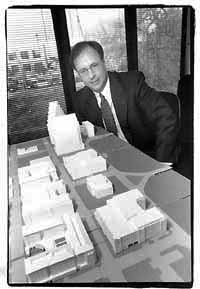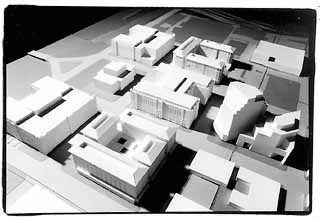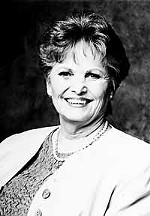If You Build It ...
What Dreams May Come
By Kevin Fullerton, Fri., Feb. 5, 1999
 In West Austin, where the major new developments such as the Austin MarketPlace and Scott Young's proposed Museum Park office complex are scoring high on the city's Smart Growth matrix, architectural renderings of the future buildings are visually inviting -- surrounded by landscaped plazas, shaded with awnings, with built-in boarding lanes for buses, and self-contained parking. Museum Park, across San Antonio from Republic Square, will feature a native limestone exterior and a trellis-shaded plaza. Post Properties' Poleyard apartment complex is being sculpted to fit in with the Shoal Creek Greenway renovation. Skeptics of the potential CSC complex have worried, however, that the massing of three office buildings on the city's prized lakeside property would impose a hulking homogeneity out of keeping with Austin's eclectic character. CSC hasn't made any architectural proposals for its downtown campus available to the public, but UT School of Architecture dean Lawrence Speck, who's been hired by CSC to work on those designs, says there's a "remarkable continuity" between the layout as now conceived and the artistic renderings dreamed up in the 1980s for the Municipal Office Complex. "It's a modification; it's not exactly what the MOC was, but it's awfully close," says Speck. "And certainly, experientially, in an urban design sense, it's almost identical." Cotera agrees, saying the CSC plan emulates the traditional city grid by not closing off streets. Speck says his suggestion for the buildings' exteriors will be native stone, perhaps like that being used for the new state building at 15th and Congress. "I think downtown there should not be too much pomposity, not like Madison Avenue," says Speck. "It ought to have a quality of still being a little raw, a little funky maybe, not too slick or prissy."
In West Austin, where the major new developments such as the Austin MarketPlace and Scott Young's proposed Museum Park office complex are scoring high on the city's Smart Growth matrix, architectural renderings of the future buildings are visually inviting -- surrounded by landscaped plazas, shaded with awnings, with built-in boarding lanes for buses, and self-contained parking. Museum Park, across San Antonio from Republic Square, will feature a native limestone exterior and a trellis-shaded plaza. Post Properties' Poleyard apartment complex is being sculpted to fit in with the Shoal Creek Greenway renovation. Skeptics of the potential CSC complex have worried, however, that the massing of three office buildings on the city's prized lakeside property would impose a hulking homogeneity out of keeping with Austin's eclectic character. CSC hasn't made any architectural proposals for its downtown campus available to the public, but UT School of Architecture dean Lawrence Speck, who's been hired by CSC to work on those designs, says there's a "remarkable continuity" between the layout as now conceived and the artistic renderings dreamed up in the 1980s for the Municipal Office Complex. "It's a modification; it's not exactly what the MOC was, but it's awfully close," says Speck. "And certainly, experientially, in an urban design sense, it's almost identical." Cotera agrees, saying the CSC plan emulates the traditional city grid by not closing off streets. Speck says his suggestion for the buildings' exteriors will be native stone, perhaps like that being used for the new state building at 15th and Congress. "I think downtown there should not be too much pomposity, not like Madison Avenue," says Speck. "It ought to have a quality of still being a little raw, a little funky maybe, not too slick or prissy."
But even if Austin is entering a new and long-awaited period in which forward-thinking architecture that breathes life into inner city streets will finally triumph, the former social character of downtown may not be so easily rebuilt. Downtown developers talk about a future Congress Avenue that will more closely resemble the city's main street of a hundred years ago than the one we knew in the 1980s. But it's no mystery that the demand for downtown residential property is being driven by highly affluent residents. Developers speak nonchalantly of tenants who want downtown apartments they can stay in for just a few days a week to conduct business. The roster of tenants waiting to buy condominiums in Barnstone's Nokonah are wealthy political and business figures without children at home. Moreover, the average income of CSC employees is $100,000 -- enough to live comfortably in the AMLI apartments, where one-bedrooms will go for $1,100 per month. With that kind of economic pressure, downtown living is sure to be among the most expensive in town, and child-rearing families will be far and few between.
Co-existing With Chains
The type of retail that will follow the affluent downtown migration can be seen in West Austin, already a tony residential district, where high-end specialty merchandise and services proliferate. Whit Hanks' new shopping center on Fifth and Lamar, for example, is stocked with expensive women's clothing, antiques, and imports. The Austin MarketPlace, with anchor tenants Target and OfficeMax, promises more widely accessible merchandise, but other stores will veer toward the higher end. The good news for local retailers, however, is that national chains are not currently competing fiercely for the new space either in West Austin or downtown, and developers say they prefer to keep a local flavor.
"Our intention is not to create an urban mall downtown," says AMLI executive Bob Allbright, "but to provide the quintessential urban retail scene, with interesting cafes and shops, maybe even a doctor or dentist's office."
"The chains are not prepared to pay the rents required down here," Whit Hanks reports. "If this becomes really trendy, Saks could justify being here, but for now the local businesses have moved faster than the chains to get started."
But downtown and West Austin aren't just places for the rich to work and play, but also to build. Smart Growth development promises to look and wear better than what has come before, but it's expensive. The time and personnel necessary to comply with Smart Growth requirements can quickly eat up the incentive savings on smaller projects, says developer Scott Young. "If you're only talking about $10,000-$30,000 in fee waivers, you may eat that up just hiring an engineer to get through the process," he says. The projects most able to push up in the inner city will likely be fueled by large corporate tenants able to fill entire buildings -- high-tech companies, hotel chains, law firms. Young's Museum Park, for example, has been specifically rendered to simulate the feel of a suburban campus attractive to high-techers, and at least one such company is among the prospective tenants there. Downtown ordinances are already so strict as to preclude building without exemptions from the city, say developers. Land is three times more expensive than elsewhere, and now projects will also need to plan how to tie into transportation alternatives such as walking paths, bus routes or van pools, and rail lines. No one is saying those Smart Growth provisions aren't important, but don't expect a host of independent hardware or appliance stores to crop up in the inner city.
"Traffic Be Damned"
Traffic, of course, won't be improved by any amount of architectural ingenuity, but just how clogged downtown arterials will become as a result of all the new development is unknown. The CSC office complex will produce about 10,000 new trips per day, but the city is crossing its fingers that enough employees will move downtown to cut those trips by roughly 25%, down to 7,500. Although about half of CSC's employees are unmarried and thus good prospects for downtown living, that's a big if. A more reliable traffic mitigator will be the company's staggered work shifts and flex-time employment. Those arrangements have made GSD&M's traffic impact in the Sixth and Lamar area barely noticeable, West Austinites say.
The Austin MarketPlace is expected to generate about 29,000 more trips, however, all focused at an intersection already among the city's most congested, where proposed infrastructure improvements such as the Lamar tunnel will now become virtually impossible because of the disruption it would cause to the new businesses.
Assistant City Manager Toby Futrell says the downtown grid, with its wide one-way streets and synchronized signal lights, is designed to support a much busier commercial district. Developer Young agrees with that, saying the worst traffic tie-ups are growing on roads like Bee Caves, not downtown. "Based on what's happening in outlying areas, downtown is relatively free-flowing," he says. Central city property owner and developer Perry Lorenz, a partner with Barnstone on the Nokonah building, says that development has reached the point where "the traffic be damned. ... It's back to that old cliché -- you have to make people miserable until they figure out there is an alternative to their cars." To that end, Futrell says the city will lead in encouraging its employees to bike, bus, or carpool, perhaps through monetary incentives, and ask other employers to do the same. The light rail system now planned to run down Fourth could service both the downtown and West Austin districts well, but that's still years away.
Back to Reality
The prospect of people living, working, and shopping downtown -- with lights burning in the AMLI apartments in the evening and sidewalk cafes full at lunchtime -- remains an exciting vision, even if a lot of questions about the fallout are unknown. To reap many of the purported benefits of a compact urban core, the mix of goods and services available from neighborhood businesses has to complement the needs of the residents, and even the more commercially evolved West Austin lacks the feel of a self-sustaining community. There's a "tenuous balance," as former Austin Neighborhoods Council president Jeff Jack puts it, that is required to create a workable compact city and not just another affluent neighborhood. It's true, as retail studies point out, that downtown workers' incomes and lifestyles closely match the type of residential and retail opportunities that downtown presents. Not represented in the studies, however, is the influx of new workers that will come to serve the coffee, bake the bread, and run the steam cleaners. It's a cinch those people won't be moving into apartments downtown, won't find conventional bus service convenient for their rotating schedules, and won't be included in the parking allotments. If a segment of the workforce has to bus in and out of downtown every day, à laAspen, Colorado, what will that say about Austin's social character?
|
|
On the other hand, activists like Jeff Jack who have long worried about affluent techies displacing old-time Austinites from their neighborhoods should take some satisfaction that downtown development won't further gentrification. The residents already living there say they welcome the newcomers. Downtown Neighborhood Association president Chris Riley says he'll be happy to see more bodies on the street in the evenings and to make fewer trips out of the Central City. "You'd have to look real hard to find anybody downtown who opposes the CSC deal," says Riley. West End Alliance vice-president Melissa Gonzales, owner of the Morning Star Trading Company, says Lamar may once again become the boulevard it was meant to be, decorated with public art and linking her neighborhood to the greenbelt along Town Lake.
Finally, and most importantly, is the Smart Growth boom in the inner city designed to last? Will it begin an organic development trend which will both satisfy the Austin aesthetic and perpetuate itself after our consummate bridge-builder of a mayor has moved on? The first key element is that the people do indeed come downtown to live.
"People think it's going to happen, but we'll have to wait and see," says developer Lorenz. The residential demand will not likely be so overwhelming that developers won't need to be shrewd in capturing niche populations, he predicts. Word is, competition for office tenants could be fierce, too. But assuming the demand is there -- will developers keep playing Smart, given the costs? Cotera thinks so. "The conventional view is that the opposition [to Smart Growth] is from developers, and it's not true. Developers actually are the most excited about what's happening downtown because it makes for very valuable projects." Over in West Austin, Smart development has done wonders for the relationship between merchants, neighbors, and developers, as evidenced by the strength of the West End Alliance. "I'm excited about all they're putting into this," Gonzales says of the West Austin development community, "and when we go to the city with our plans, we already have consensus among the neighborhood and merchants."
Assistant City Manager Futrell says Smart Growth development will seed successful models that will be copied and standardized downtown. Smart Growth incentives may eventually become unnecessary, she says. "Right now we have almost unprecedented collaboration with developers," says Futrell. "It's the lions lying down with the lambs; I've never seen it, in all the years I've been here. I'm hoping it spins off of itself."
Got something to say on the subject? Send a letter to the editor.









